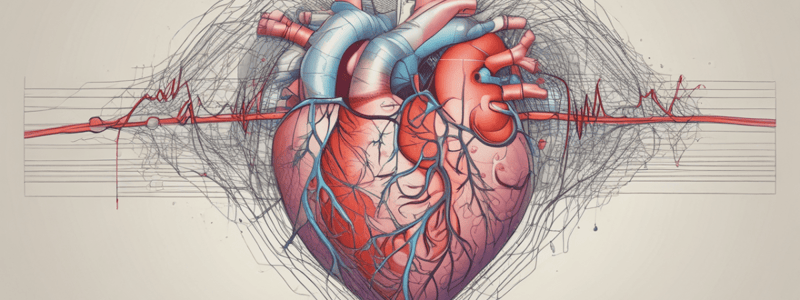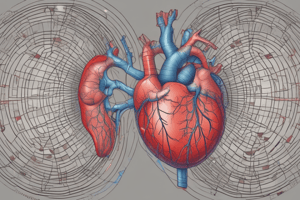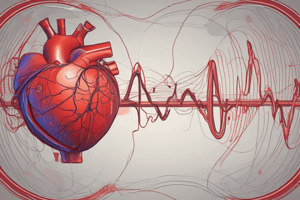Podcast
Questions and Answers
What is the term for the cyclical pattern of heart contractions and relaxations?
What is the term for the cyclical pattern of heart contractions and relaxations?
- Cardiac cycle (correct)
- Cardiac contraction
- Cardiac relaxation
- Cardiac rhythm
During which phase of the cardiac cycle does the ventricle contract?
During which phase of the cardiac cycle does the ventricle contract?
- Diastole
- Ventricular relaxation
- Atrial contraction
- Systole (correct)
What is the characteristic of blood pressure during systole?
What is the characteristic of blood pressure during systole?
- No pressure
- Variable pressure
- Low pressure
- High pressure (correct)
What happens to the ventricles during diastole?
What happens to the ventricles during diastole?
What is the term for the active contraction of ventricles?
What is the term for the active contraction of ventricles?
The cardiac cycle is a pattern of heart contractions and relaxations that occurs in a random sequence.
The cardiac cycle is a pattern of heart contractions and relaxations that occurs in a random sequence.
During systole, the ventricles fill with blood from the atria.
During systole, the ventricles fill with blood from the atria.
The pressure in the ventricles is low during systole.
The pressure in the ventricles is low during systole.
Diastole is the phase of the cardiac cycle where the ventricles actively contract.
Diastole is the phase of the cardiac cycle where the ventricles actively contract.
The atria fill with blood during systole.
The atria fill with blood during systole.
The cardiac cycle is a pattern of heart contractions and relaxations that occurs in a constant sequence.
The cardiac cycle is a pattern of heart contractions and relaxations that occurs in a constant sequence.
During diastole, the ventricles empty into the aorta and pulmonary arteries.
During diastole, the ventricles empty into the aorta and pulmonary arteries.
The phase of the cardiac cycle characterized by ventricular relaxation is called systole.
The phase of the cardiac cycle characterized by ventricular relaxation is called systole.
The heart contracts and relaxes in a cyclical pattern in response to mechanical changes within the cells.
The heart contracts and relaxes in a cyclical pattern in response to mechanical changes within the cells.
Blood pressure is high during diastole.
Blood pressure is high during diastole.
What is the purpose of maintaining blood pressure within an ideal range?
What is the purpose of maintaining blood pressure within an ideal range?
What happens to blood pressure during systole?
What happens to blood pressure during systole?
What is the consequence of blood pressure being too low?
What is the consequence of blood pressure being too low?
What is the term for the ventricular relaxation phase of the cardiac cycle?
What is the term for the ventricular relaxation phase of the cardiac cycle?
What is the result of high blood pressure?
What is the result of high blood pressure?
What system helps maintain blood pressure within the ideal range?
What system helps maintain blood pressure within the ideal range?
The heart contracts and relaxes in a cyclical pattern in response to ______ changes within the cells.
The heart contracts and relaxes in a cyclical pattern in response to ______ changes within the cells.
The ______ contraction of ventricles is called systole.
The ______ contraction of ventricles is called systole.
If the blood pressure is too high, it can cause ______ to the tissues.
If the blood pressure is too high, it can cause ______ to the tissues.
If the blood pressure is too low, it won't supply the organs with enough ______ or oxygen.
If the blood pressure is too low, it won't supply the organs with enough ______ or oxygen.
The ______ of ventricles from the atria occurs during diastole.
The ______ of ventricles from the atria occurs during diastole.
High blood pressure is also known as ______.
High blood pressure is also known as ______.
Match the following phases of the cardiac cycle with their characteristics:
Match the following phases of the cardiac cycle with their characteristics:
Match the following terms with their definitions:
Match the following terms with their definitions:
Match the following consequences with the corresponding blood pressure condition:
Match the following consequences with the corresponding blood pressure condition:
Match the following statements with the correct phase of the cardiac cycle:
Match the following statements with the correct phase of the cardiac cycle:
Match the following systems with their functions in maintaining blood pressure:
Match the following systems with their functions in maintaining blood pressure:
Match the following phrases with their corresponding descriptions:
Match the following phrases with their corresponding descriptions:
Match the following phases of the cardiac cycle with their characteristics:
Match the following phases of the cardiac cycle with their characteristics:
Match the following blood pressure conditions with their consequences:
Match the following blood pressure conditions with their consequences:
Match the following systems with their functions in maintaining blood pressure:
Match the following systems with their functions in maintaining blood pressure:
Match the following descriptions with the correct phase of the cardiac cycle:
Match the following descriptions with the correct phase of the cardiac cycle:
Match the following terms with their definitions:
Match the following terms with their definitions:
Match the following characteristics with the correct phase of the cardiac cycle:
Match the following characteristics with the correct phase of the cardiac cycle:
Flashcards are hidden until you start studying




